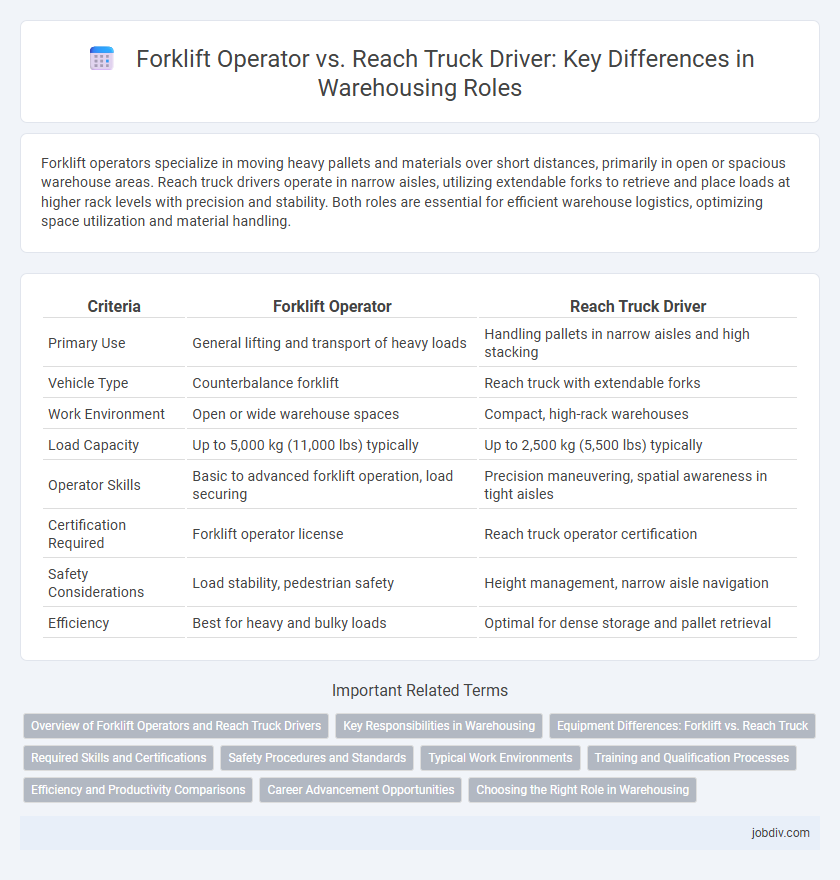Forklift operators specialize in moving heavy pallets and materials over short distances, primarily in open or spacious warehouse areas. Reach truck drivers operate in narrow aisles, utilizing extendable forks to retrieve and place loads at higher rack levels with precision and stability. Both roles are essential for efficient warehouse logistics, optimizing space utilization and material handling.
Table of Comparison
| Criteria | Forklift Operator | Reach Truck Driver |
|---|---|---|
| Primary Use | General lifting and transport of heavy loads | Handling pallets in narrow aisles and high stacking |
| Vehicle Type | Counterbalance forklift | Reach truck with extendable forks |
| Work Environment | Open or wide warehouse spaces | Compact, high-rack warehouses |
| Load Capacity | Up to 5,000 kg (11,000 lbs) typically | Up to 2,500 kg (5,500 lbs) typically |
| Operator Skills | Basic to advanced forklift operation, load securing | Precision maneuvering, spatial awareness in tight aisles |
| Certification Required | Forklift operator license | Reach truck operator certification |
| Safety Considerations | Load stability, pedestrian safety | Height management, narrow aisle navigation |
| Efficiency | Best for heavy and bulky loads | Optimal for dense storage and pallet retrieval |
Overview of Forklift Operators and Reach Truck Drivers
Forklift operators and reach truck drivers are essential warehouse professionals responsible for efficiently moving and stacking materials. Forklift operators typically handle a wide variety of loads in open areas, operating standard forklifts designed for versatility and heavy-duty lifting. Reach truck drivers specialize in maneuvering narrow aisle reach trucks to access high shelves and tight spaces, optimizing vertical storage and inventory management in confined warehouse environments.
Key Responsibilities in Warehousing
Forklift operators in warehousing are responsible for safely moving, stacking, and organizing heavy loads using counterbalance forklifts, primarily handling pallets and bulky materials. Reach truck drivers specialize in operating reach trucks to access high shelves and narrow aisles, efficiently managing vertical storage and optimizing warehouse space. Both roles require adherence to safety protocols, equipment inspections, and precise load handling to maintain inventory accuracy and operational flow.
Equipment Differences: Forklift vs. Reach Truck
Forklifts typically feature a counterbalance design with forks extending from the front, allowing them to lift heavier loads and operate efficiently in outdoor and uneven environments. Reach trucks are equipped with extendable forks and a mast that can reach deep into warehouse racks, making them ideal for narrow aisle operations and high stacking in indoor settings. The primary equipment difference lies in maneuverability and lifting height, with reach trucks offering greater vertical reach and compact turning radius, while forklifts provide robust lifting power and versatility on varied surfaces.
Required Skills and Certifications
Forklift operators and reach truck drivers both require OSHA certification to ensure safe operation but differ in specialized skills; forklift operators must master maneuvering in varied warehouse environments while reach truck drivers specialize in handling narrow aisle racking systems with extended lifting capabilities. Reach truck drivers need advanced spatial awareness and precision to operate equipment designed for higher stacking, often requiring additional training on reach truck-specific controls and safety protocols. Both roles demand strong communication skills, physical coordination, and adherence to safety regulations to prevent accidents and maintain efficient warehouse operations.
Safety Procedures and Standards
Forklift operators and reach truck drivers must adhere to strict safety procedures, including regular equipment inspections, proper load handling, and maintaining clear visibility. Compliance with OSHA standards mandates wearing personal protective equipment (PPE), following designated pathways, and conducting pre-operation safety checks to prevent accidents. Both roles require comprehensive training programs emphasizing hazard recognition and emergency response protocols to ensure workplace safety in warehousing environments.
Typical Work Environments
Forklift operators typically work in open warehouses, loading docks, and outdoor storage yards where maneuverability in tight spaces is less critical. Reach truck drivers are specialized for narrow aisle warehouses and high racking systems, navigating confined spaces with precision. Both roles are essential for inventory handling, yet they adapt to distinct environments based on equipment capabilities and spatial constraints.
Training and Qualification Processes
Forklift operators typically undergo comprehensive training programs covering basic forklift operation, safety protocols, and load handling, often culminating in certification recognized by OSHA or similar regulatory bodies. Reach truck drivers require more specialized training focused on maneuvering in narrow aisles, precise load placement at height, and handling extendable forks, with certification reflecting these advanced skills. Both roles demand periodic refresher courses to maintain compliance with safety standards and operational efficiency in warehousing environments.
Efficiency and Productivity Comparisons
Forklift operators excel in handling heavy loads and large pallets, making them ideal for outdoor and rough terrain environments, which enhances overall warehouse efficiency. Reach truck drivers specialize in maneuvering within narrow aisles and high racking systems, significantly boosting productivity in dense storage setups. Comparing both, reach trucks deliver greater precision and speed in confined spaces, while forklifts provide versatility and strength for varied material handling tasks.
Career Advancement Opportunities
Forklift operators have foundational skills that can transition into roles such as warehouse supervisors or inventory managers with experience and additional training. Reach truck drivers, trained in handling high-reach equipment, often advance more quickly into specialized logistics positions or equipment maintenance roles due to their technical expertise. Both career paths benefit from certifications like OSHA and continuous professional development to enhance upward mobility in warehousing operations.
Choosing the Right Role in Warehousing
Choosing the right role in warehousing depends on the specific tasks and environment: forklift operators excel at handling heavy loads and loading/unloading trucks, while reach truck drivers specialize in navigating narrow aisles and stacking pallets at higher elevations. Forklift operators typically work in open spaces with versatility in load types, whereas reach truck drivers are essential for optimizing storage density in high-rack warehouses. Assessing warehouse layout, load types, and storage requirements ensures selecting the role that maximizes operational efficiency and safety.
Forklift Operator vs Reach Truck Driver Infographic

 jobdiv.com
jobdiv.com